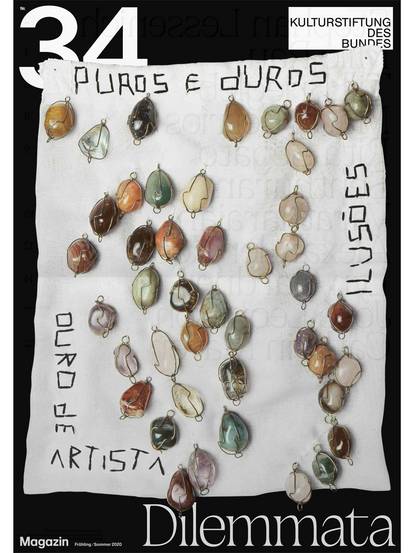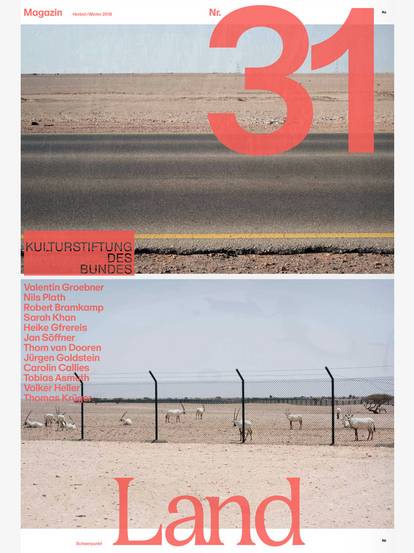Is our perspective on cohabitation too anthropocentric? The Indian author Sumana Roy seeks the company of plants and marvels at people who insist on "their space" as a rightful privilege and property.
The arrival of this phrase must have marked my real entry into adulthood – hearing someone say ‘I need my space’, and then internalizing it as one of the necessary demands one makes of a relationship. But the truth is that I never felt the need to use it. Either I was lucky to not have been among people who barged into my space or I was the kind of person who had not been formed by the notion of a space that was exclusively mine – like a fingerprint, no, like a footprint, that takes up space. I hadn’t ever heard my parents say that to each other or to us, and though we had a small house, with tiny rooms from which all of us moved in and out constantly, and we fought with each other like most families, we did not demand ‘space’ from each other. I cannot remember a time from my childhood, besides when I was left alone at home because of my recurring illness while others had to go to work, when I was ever by myself in a room.
Uncles and aunts from my father’s village were itinerant visitors – they slept on the bed that had otherwise been allotted to my brother and me. The aalna – a rickety clotheshorse, a gift from my parents’ wedding – would grow obese with their clothes, particularly in the winter, but it stood standing, like our old house, always being able to make space for another. It must have been from a conditioning in such a life that created the ethic for my heart – where there would always be space for one more person, and then another, and then another. For I know of no other continent that is as populated as the heart. It is, for me, the best metaphor for cohabitation – things and people and places and emotions learn to live there without any great violence, without riots.
In the house with uncles and aunts and grandparents who came and left to their will were animals – dogs and cows and goats and hens and crows and sparrows, none of these ‘pets’, but those who were always eager to make a meal of anything thrown or discarded at the slightest opportunity. There were the catfish in the wells, apparently kept there to keep the water clean. And there were the plants. Who had planted them?
No one bothered with these questions, taking them as expected and natural as the cohabitation of body and shadow or body and mind. It wasn’t childhood which allowed such an idea of the world, of it being a place where forgetfulness was not just allowed but necessary – that it was alright for the leaf to be forgetful of the epithelium of dust on it just as it was for the water to be forgetful of the weight of a leaf on it. That the same thing could be both – bear the pressure of another and also impress its weight on someone else – was our conditioning in cohabitation: to be both agent and acted upon, like the leaf which holds dust, but it also held by water. Much later, when childhood would seem like a dream or a book that one had borrowed from a library, I would discover an analogy in the spiritual thinker Guru Nanak’s thoughts: ‘The Guru … took a jasmine petal and let it float gently on the surface of the milk, implying that his presence would not uproot anyone’.
Cohabitation, I learnt from looking at plants, was in the rejection of ownership.
≈
One day I heard a television chef say this when chopping mint: ‘Don’t run the knife at the same place twice. It’ll make it bleed …’ I cannot remember anything else, what he was cooking, or how he used the mint. All I kept thinking was this: from whose point of view was he thinking, the human tongue’s or the mint leaves’? The wok or the cooking pot is a great metaphor for cohabitation – the difference between the ‘melting pot’ and the ‘salad bowl’ models of culture have been whipped to froth. That is not what I mean though. When a chef says that garlic agrees with olive oil and lemon, whose point of view do we imply? It is easy to say that it is an anthropocentric view, and that such a conditioning in taste implies the human’s. But is there a possibility that it is in the genetic character – I use ‘genetic’ only as shorthand – of garlic to disagree with milk and sweetness as it is for onion to form a natural friendship with garlic and chillies?
I say cohabitation even though I interpret it as friendship. I import my ideas of human companionship into a nonhuman setup and fail immediately. By my wrong logic, even the knife cutting through the mint leaves can be seen to be in dialogue with them. But the result of such a dialogue is death. What then?
How do we cohabitate without destroying or killing the other?
≈
Cohabitation is also the rejection of conformity – the demand we make on others to become like us. We want those we love to say the things they say in a way we can understand. I am thinking of the Indian scientist Jagadish Chandra Bose, who ‘proved’ to the world that plants are ‘living and sentient beings’. How he, trained as a physicist, came to the botanical sciences, is now a well-known anecdote. On a walk in Calcutta, he accidentally touched the leaves of the Mimosa pudica, also known as the ‘touch-me-not’. The leaves shrank from his touch. He was surprised, even shocked. Always having associated ‘response’ as a mark of the living, he spent his life arguing for greater respect to plant life.
Jagadish Bose, in his obsession to prove that plants deserved as much dignity as humans and other animals, designed various kinds of instruments to measure and calibrate the responses of plants to the elements, most particularly to water, air, and heat. He wanted plants to respond in their own ‘handwriting’. His word for that, in Bangla, was ‘torulipi, the plant script. Whimsical and idiosyncratic in ambition, affectionate in the need to hear his favourite plants speak, the idea of the plant script is utopic. It tells us to annotate our idea of cohabitation to accommodate difference of another kind – when two beings who do not share a language, like humans and plants don’t, they can still cohabit. Cohabitation – and conversation – does not need a shared language.
≈
After nearly a year of forced social distancing, of protecting myself from the virus so as to be able to protect those with whom I share my surroundings, I decide to go out with my family. We will go to the forest, a forest nearby – so it is decided. The rationale for this is not hard to find – we do not want to meet humans, possible carriers of the virus. We do not say any of this to each other, but when we reach the forest, the place from which we will have to walk into it, we get down from the car without speaking to each other. My two-year-old niece makes a sound as we are about to enter. It’s a sound, not a word – for the flock of pigeons that seem to have jumped into the sky at once. ‘Whoosh.’ My nephew asks what we’d do if we met a tiger. ‘Do you want to shake its hands?’ I whisper into his ears.
The forest is there almost exactly as we left it more than a year ago. It has changed, but it is not the sky, which likes to reveal its changing life. This is not the stubbornness of the forest but its character – it is like the inside of our mouths that is being constantly replenished with new saliva that remains invisible to the world. When my nephew first saw a forest, he was about four years old, and was just entering a life in language. He declared that ‘forest’ meant ‘for rest’. He is now nine, and instead of rest, he now imagines it as a place for freedom, that would allow him to run in a way his small house with its many packed rooms did not. I smiled inside my mask as I thought of this – how the forest allowed both habitation, rest and its obverse, whatever that might be.
Inside it – for my nephew had indeed asked what was to be found inside a forest, a question for which we’d had no answer – was nothing and everything all at once. I did not know the names of most of the trees, and I presumed that they were not insulted by this lack of knowledge on my part as humans are, when we go to meet them without an awareness of their names and social and professional designations. Even though the government’s forest department had been responsible for the afforestation programme that had kept the forest alive, one that usually introduces homogeneity, because it is easy to plant one or a couple of species on a replanting overdrive, there were a variety of races of trees in whose midst we stood. I do not use the word casually: race. And, soon after, other categories from the sociological world entered my consciousness: class and caste. The forest and its residents were without these markers, and I wanted to feel in this what I had always felt intuitively – the natural cosmopolitanism of the forest. The human’s hierarchical imagination had imposed the idea of king and kingdom in the animal world inside the forest – there was a ‘king of the forest’, after all. In this forest, with trees whose only visible sign of power was in their height, there seemed to be place for everyone. And everything. I say the latter because of my immediate memory of my nephew pointing to a heap of red cloth wallets left under a tree. They were usually given by jewellers to buyers. It was possible – and what can stop the imagination from being thrilled? – that a group of dacoits had looted a house or a jewellery store, then come here, plucked out the gold and diamond from inside them and abandoned the purses in a hurry. I say hurry because right beside the red wallets was a pair of well-worn black shoes. The trees in the forest, even though they didn’t need the black shoes for walking, had accepted it in their midst, as they had the empty purses. Not gold or silver, but a seed, perhaps even spores, could accumulate inside them and grow into something. I do not mean to turn the forest into a homily about natural cohabitation, but when I think of a metaphor of accommodativeness, I think of two things: the human heart, the most highly populated region in the world, one larger than the world itself; the forest, which keeps growing without bothering about being contained, which will find space for everything, light and darkness, spit and rain, moss and canopy, all kinds of opposites defined by the limits of the human imagination. It is common to think of the forest as self-contained; I tend to think of it as uncontainable, but, like the human heart, it knows how to keep everything in place without destroying itself. The notion of overcrowdedness, so used for human habitation, is foreign to the human heart and the forest.
My niece sat on a low branch of a tree and broke the self-imposed curfew on human silence. Perhaps we were trying to speak the language of the trees without awareness? She called out to her mother. ‘Ma …’
Soon she was in her mother’s arms. I took a photo though it was now dark. When I was home, I noticed the two photos of her on my phone: of her holding the tree while sitting on it, and her holding her mother. The posture in both looks very similar. Their shadows too might have looked similar, I think, had the forest floor allowed shadows. That might be the only thing it excludes – the day residency of shadows. For a moment I wonder why, until a thought brings me back to my old equivalence: no shadows fall on the human heart either.
≈
It is raining now, as I write the last few lines of this essay. Winter rain, never welcome. I pull an extra blanket up to my waist and look out to the balcony. In the crocheted darkness of the balcony, partially hidden from me by creepers resting on the glass windows, are birds waiting out the showers. I know them from their bird calls. I have lived so long with them that I have given these sounds names. At first these names were of the sounds and their relation to the time of the day. ‘Pik Pik Noon’ – this tiny one, as one can make out from the onomatopoeic first name, would arrive around noon and not leave until some food was given to it. The names have changed over time.
The tiniest of them, that look like sparrows but are smaller than them, refuse to sit on any branch. They head straight to the mustard plants that grow in a large flat pot. I’ve occasionally seen them look at their shadow on the floor – they lose the shadow, after all, when they climb high into the sky. I wonder who they cohabitate with better – their shadow or the sky.

![[Translate to English:] Magazine 38](/fileadmin/_processed_/f/1/csm_Magazin38_Cover-Vorschau_921x1230_689f428dc3.jpg)
![[Translate to English:] Magazine 37](/fileadmin/_processed_/b/c/csm_Mag37_Cover-Vorschau_921x1230_b5129fdb2a.jpg)
![[Translate to English:] Magazine 36](/fileadmin/_processed_/2/a/csm_Cover_Magazin36__issuu_2f3cef97bb.jpg)





![[Translate to English:] Magazine 30](/fileadmin/_processed_/c/b/csm_magazin30_vorschau_9005f773d3.jpg)














